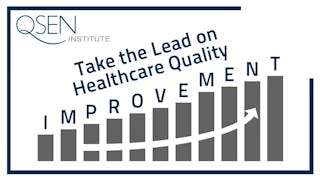In this course, you will have the opportunity to learn about the great progress that has been made in measuring and evaluating quality of care. We will discuss key concepts and methods. You will also learn about how to use websites for comparing the quality of healthcare providers. The course content is intended for a wide range of participants – for example, people who have a general interest in quality of care, consumers seeking information about how to choose a provider for themselves or family members, or leaders of business organizations who are responsible for employee health insurance benefits and network of providers.


Evaluating the Quality of Healthcare Delivery
This course is part of Healthcare Trends for Business Professionals Specialization

Instructor: Gary Young
4,399 already enrolled
Included with
(38 reviews)
What you'll learn
Explain key developments regarding how quality of care is measured and evaluated in the US.
Discuss scientific issues and challenges for evaluating quality of care and methods for addressing these challenges.
Identify and apply resources and tools for comparing the quality of care of providers.
Articulate basic framework for evaluating quality of outcomes of care for evaluating and comparing providers.
Skills you'll gain
Details to know

Add to your LinkedIn profile
See how employees at top companies are mastering in-demand skills

Build your subject-matter expertise
- Learn new concepts from industry experts
- Gain a foundational understanding of a subject or tool
- Develop job-relevant skills with hands-on projects
- Earn a shareable career certificate

There are 4 modules in this course
We will begin by briefly discussing key developments in the U.S. and elsewhere underlying changing perspectives toward the way quality of care is defined and evaluated. We will then outline and discuss a basic conceptual framework for selecting measures for evaluating the quality of care by hospitals and physicians. This discussion will draw attention to key distinctions between process and outcome measures and their relative advantages and disadvantages for evaluating quality of care. This module will also include examples of quality measures that are currently in use.
What's included
10 videos2 assignments3 discussion prompts
We will discuss key challenges in making valid comparisons among healthcare providers in terms of their quality of care including case mix differences, small sample sizes and data integrity issues. We will discuss methods and techniques for addressing such challenges. We will show how these methods and techniques can be applied in practice to produce more useful quality of care evaluations.
What's included
7 videos2 assignments2 discussion prompts
We will cover consumer report cards and value-based purchasing programs, both of which constitute important applications of the science of measuring and evaluating quality of care. Consumer report cards on quality of care frequently exist within publicly available websites. These websites provide consumers and other interested parties with quality-related information for comparing the performance of hospitals and physicians. Such resources and tools have been produced by government agencies, private health plans, and business organizations. We will look at several examples of these resources and tools and consider their value as well as their limitations.
What's included
6 videos1 assignment1 peer review3 discussion prompts
We will discuss emerging developments pertaining to the science and practice of evaluating quality of care. This discussion will include the increased interest in value-oriented measures of provider performance (i.e., efficiency as well as quality) and in composite measures. Also, we will consider the debate over whether quality measures should be adjusted to account for differences among providers regarding the socio-economic characteristics of their patients and how such adjustments could be conducted.
What's included
4 videos1 assignment1 peer review2 discussion prompts
Earn a career certificate
Add this credential to your LinkedIn profile, resume, or CV. Share it on social media and in your performance review.
Instructor

Offered by
Explore more from Healthcare Management
 Status: Free Trial
Status: Free TrialRutgers the State University of New Jersey
 Status: Free Trial
Status: Free TrialUniversity of Michigan
 Status: Free Trial
Status: Free TrialUniversity of Houston
 Status: Preview
Status: PreviewCase Western Reserve University
Why people choose Coursera for their career





Open new doors with Coursera Plus
Unlimited access to 10,000+ world-class courses, hands-on projects, and job-ready certificate programs - all included in your subscription
Advance your career with an online degree
Earn a degree from world-class universities - 100% online
Join over 3,400 global companies that choose Coursera for Business
Upskill your employees to excel in the digital economy
Frequently asked questions
To access the course materials, assignments and to earn a Certificate, you will need to purchase the Certificate experience when you enroll in a course. You can try a Free Trial instead, or apply for Financial Aid. The course may offer 'Full Course, No Certificate' instead. This option lets you see all course materials, submit required assessments, and get a final grade. This also means that you will not be able to purchase a Certificate experience.
When you enroll in the course, you get access to all of the courses in the Specialization, and you earn a certificate when you complete the work. Your electronic Certificate will be added to your Accomplishments page - from there, you can print your Certificate or add it to your LinkedIn profile.
Yes. In select learning programs, you can apply for financial aid or a scholarship if you can’t afford the enrollment fee. If fin aid or scholarship is available for your learning program selection, you’ll find a link to apply on the description page.
More questions
Financial aid available,
¹ Some assignments in this course are AI-graded. For these assignments, your data will be used in accordance with Coursera's Privacy Notice.

